When the National Transportation Safety Committee revealed the factual information on the QZ8501 accident, their 18 point press release and the questions and answers made on 29 January, revealed nothing that was previously unexpected. However, not long after that, Bloomberg and later Reuters, began running a story that the Captain was not in his seat at some point in the accident.
The Snowball
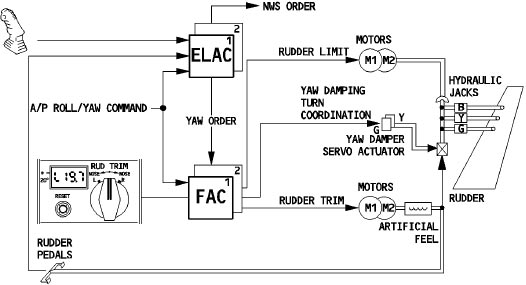
The revelation comes from unnamed sources “close to the investigation”, stating that the crew were switching off the aircraft’s Flight Augmentation Computers (FAC). Initially, most of the media wrote that “crew switched off critical computers before crash.” Well, the FAC is critical but switching them off, shouldn’t cause the airplane to crash. Some media did attempt to make the aircraft’s reconfiguration to Alternate Law for the flight control system as making the airplane hard to control, leading to the crash. Flying in Alternate Law is no big deal, although you must be aware that the aircraft no longer protects you from stalling, overspeeding, or rolling over inverted.
The media spin, has turned this item into a snowball.
The Avalanche
On Friday, Bloomberg reported that “one person/people familiar with the investigation” said that the after trying to reset the device the captain pulled the circuit breaker on the device (FACs). Reuters seemed to have made the jump from “switching the device off” to “pulling the circuit breakers.” This was the start of the avalanche.
- The circuit breaker for the FAC, cannot be reached easily from the seat, so someone had to leave or stretch out quite far from his seat.
- There is no Airbus procedure that asks for the crew to pull the circuit breakers to switch off, or reset the Flight Augmentation Computers on the A320.
Having a 2 reputable global media on this, obviously led to a global newsfeed frenzy pumping news of “captain left his seat” to all corners of the world.
My own little investigation
The skeptical me thought something does not seem right. Pilots do not make up procedures in troubleshooting. If global media can use unnamed sources, then why can’t I call my unnamed source. The difference being that my source isn’t someone familiar with the investigation, he is in the investigation team. So I asked.
The answer from my source, was that Bloomberg and Reuters may have been misled or got lost in the translations. The investigating team have not made such a conclusion or have not found evidence of the captain leaving his seat, presumably based on the conversations heard in the CVR. My source said that both crew were troubleshooting (with one flying and one troubleshooting), that FAC fault (unclear single or dual) was mentioned, and that the crew did not make up troubleshooting procedures as they went along.
As previously it was reported that the stall warnings did go off, it can be assumed that the aircraft was not flying in Normal Law (where the airplane is protected from stalls, overspeeding, or rolling over) but in Alternate Law instead. Combine this with previous news that the FACs were both switched off, let’s have a quick look at the DUAL FAC Fault procedure:
Enough talk of the circuit breakers. Let’s see if turning off the FACs require pilots to leave their seat. Here is the A320 cockpit and where the FAC switches are on the overhead panel:
As you can see, it is reachable from the pilot seats. However, the captain may need to stretch or loosen his seat harness to reach the FAC2 switch, and the same for the first officer to reach the FAC1 switch. This, is very different from “leaving his seat.”
My Conclusions on the Avalanche
How did the story went from switching off the FAC to pulling the circuit breaker, and from stretching to reach a switch to become the captain leaving his seat?
My simple answer: it got lost in the translation!
Simple confusion from a writer not realizing that that resetting the FACs and switching it off involve the same push-button switch could lead to the belief that switching it off means pulling the circuit breaker.
The need to stretch to reach a switch, given language barriers (eg: if source and the media speak in different languages), can result in difficulties of the context of the captain’s movement in his seat. Combined with the confusion over switch vs circuit breaker, put the two together, and there you have it, “he must have left his seat to reach the circuit breaker.”
Mainstream journalists are mostly not aviation journalists, and often even their news bureau rely on aviation experts to convert the technical language into layman’s terms. This adds another translation barrier for the context to be conveyed correctly.
On sunday morning, one of the local media, Tempo, put out a piece stating that the NTSC denies the stories that the captain left his seat (link in Indonesian only). The Investigator In Charge was quoted, saying “Fiction! There was no such thing!” Unfortunately the article is titled “NTSC denies that Captain left the cockpit”, but luckily I know the author so I asked him if he meant “left the cockpit” or “left his seat”. The answer is: BOTH!
Let’s see if Bloomberg and Reuters will update their stories quoting the NTSC’s refuting that the captain left his seat.
UPDATE:
Late on Monday 2 February, Reuters has put out a story that the investigators say no evidence that the captain left his seat.

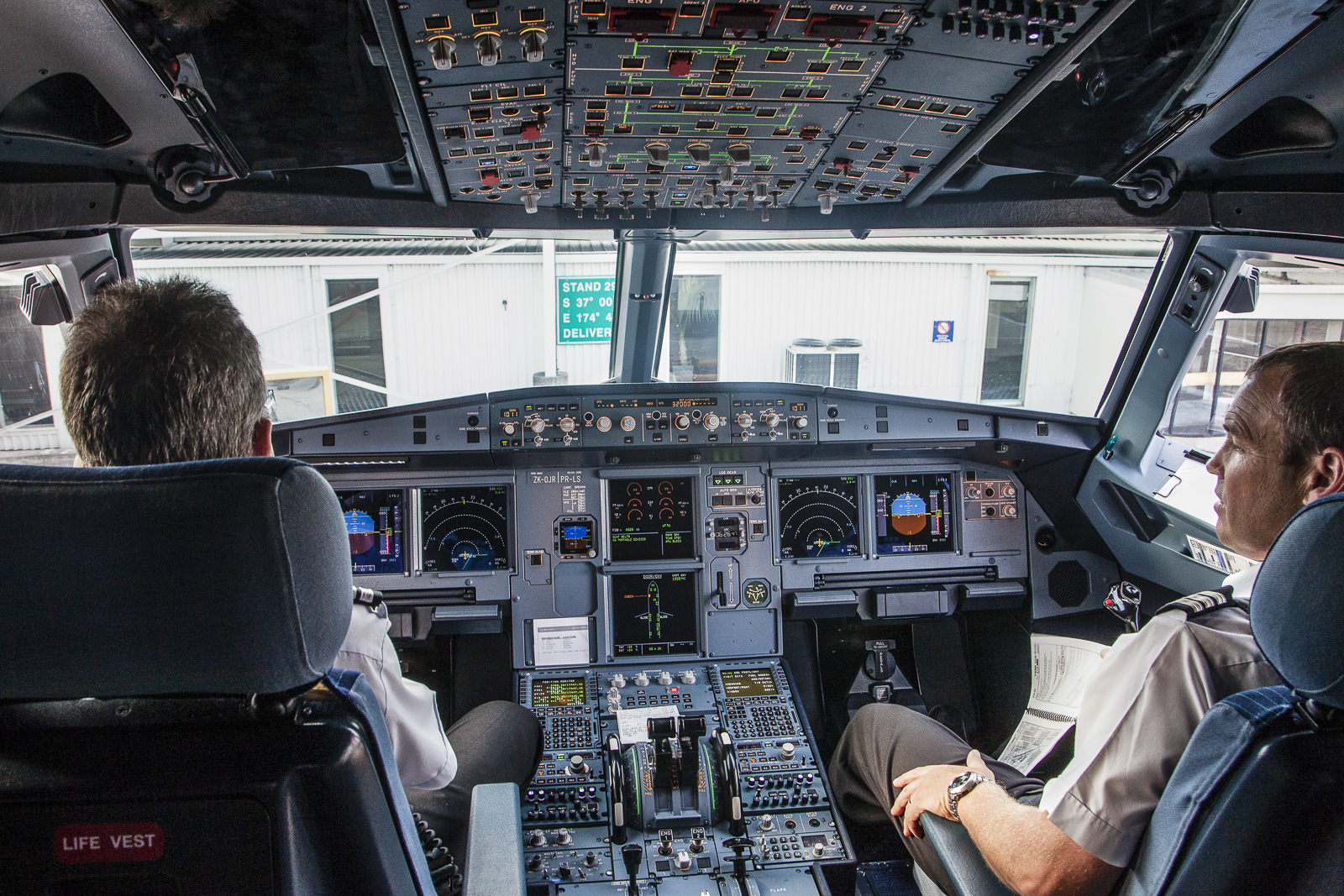
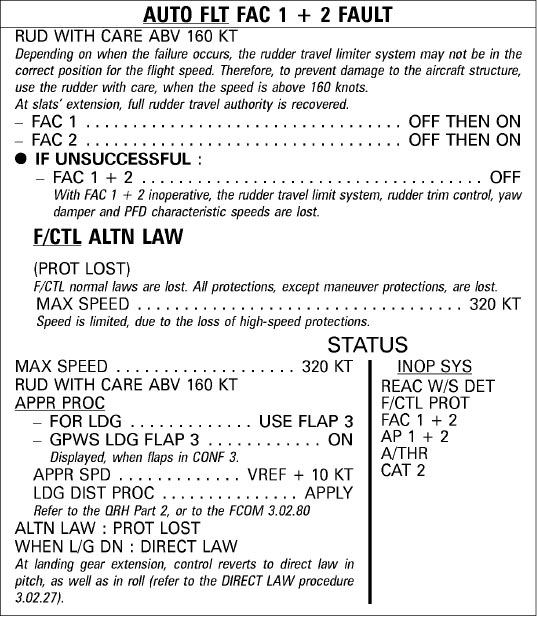
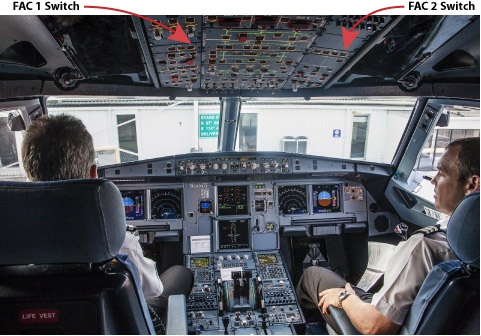
Hi GerryS, I have a quick question for you. Early on, after the crash, they mentioned sending the lung samples to the lab to test for plankton etc. to see if anyone perhaps survived the impact. Did we ever get the autopsy results back for that?
The cause of the Air Asia QZ 8501 and the Air France A-330 accident are the same:
QZ 8501 – Strong thunderstorm updraft causes aircraft rate of climb to increase to an extreme level, airspeed increases to above limits, ELAC senses the over-speed, takes control of aircraft, pulls nose up and reduces both engines toward idle, elevator trim repositions to the maximum slow speed/nose up position. The updraft ends, airspeed immediately is reduced to below low speed/angle of attack stall, aircraft immediately enters an aggravated, slow speed stall in very high nose up attitude with engines in idle thrust and elevator trim in max slow speed, nose up position.
Aircraft rate of climb is a sink rate of up to 18, 000 feet per minute.
Pilots can not influence controls. Pilots can not override ELAC. ELAC is overriding the Pilots.
ELAC now senses the low sped stall, increases thrust to maximum and pushes elevator control full forward. But elevator trim is in full nose up position. The Stab Trim Clutch/Brake prevents the elevator from trimming to a faster speed, nose down position due to the full forward, nose down position of the elevator control (joy stick). The only way to trim to a higher speed is release the full forward elevator input, trim to a higher airspeed, then push the nose over (down). However, the ELAC is not programed to temporarily release the nose-down elevator input while in the nose-up low speed stall. The elevator trim brake locks the trim actuator from trimming nose down. Both engines are in Max thrust, which causes the aircraft to nose up.
The Pilots are prevented by the ELAC from releasing up elevator, trim for a higher speed, and recover from the stall.
Two to four minutes after entering the aggravated stall, the aircraft violently hits the water still in the stall, and breaks apart.
Air France A-330:
Pitot Heat is lost and Pitot tubes ice over, causing the airspeed indicators to display a very high airspeed, Pilots follow training and pull nose up to an extreme high attitude while pulling both engine’s thrust levers to idle. ELAC takes control of aircraft away from pilots due to high speed indications.
Aircraft autopilot auto-trim positions the elevator to full nose up, slow speed position as the elevator control is pulled up.
Aircraft enters high altitude, aggravated slow speed stall in a very high nose up, throttles in idle, full nose up elevator trim condition, and hits the water a few minutes later in this attitude, same as Air Asia QZ 8501.
France and Airbus did the investigation. The ELAC over riding of control of the Pilots was not divulged.
I have stalled many Air Force aircraft, most Boeing airliners, and the Airbus 300. Swept wing aircraft behave differently from straight wing aircraft entering a stall. The nose falls quickly into a nose down position and usually one wing stalls before the other wing, causing an immediate roll to that side in a straight wing aircraft. In a swept wing aircraft such as the Airbus 320/330, the aircraft remains nose up, wings level. But the rate of descent is extremely high. It will lose a great deal of altitude very quickly even if the Pilot initiates Stall Recovery procedures immediately.
Boeing observed that Neil Armstrong had to takeover from the three autpilot computers when landing on the moon.
Boeing then made the policy decision of never taking final control away from the Pilot.
Airbus proceeded in the opposite direction.
The autopsy as far as I know only cover the crew. The passengers by law over here need the approval of the relatives for an autopsy. As far as I know, none of the autopsy results has been made public so far.
The A330 doesn’t have an ELAC. It is controlled by PRIMs and SECs, unlike the 320.
No, the causes of the two accidents are NOT the same.
There is zero evidence of ELAC sensing overspeed at this moment.
Gerry,
Pardon, Gerry, but your reply to my post implies that you are limited in your knowledge.
First: It does not matter if you call the system, ELAC, PRIMs. SECs, or the XYZ, they all are Pilot Control Override Systems (PCOS), which when certain parameters are exceeded, removes control of the aircraft from the Pilots.
Second: Yes Gerry, both accidents have the same cause: The Pilots could not recover from a stall because the ELAC, PRIM, or SEC had taken control away from them, and would not give control back in the two minutes before they hit the water. In fact, with a sink rate of 20,000 feet/min., the PCOS had to return control of at least the rudder within the first minute to avoid hitting the water. The problem is that once the stall is entered, the PCOS will never relinquish control, because the IAS remains in two figures, and the PCOS can not recover from the stall. Upon entering a stall, a swept wing aircraft remains in a nose up, wings level attitude, while falling like a rock. Even at max thrust at high altitude, the airspeed will not increase due to the very high drag. I have stalled every aircraft I have flown during 27,000 flight hours in the USAF and American major airlines. The swept wing all react the same, even the supersonic Air Force fighters. The PCOS system is attempting to lower the nose, maintain wings level, and Max Thrust if tied to AutoThrottles. However, the airspeed is so low that the elevator and ailerons have no effect. The only way to exit the stall is to slam in full rudder, in either direction. Assuming that the FAC has returned full hydraulic pressure and full travel to the rudder, the aircraft will fall off to the side, airspeed quickly increases, and you are out of the stall. I have stalled all Boeing jet airliners, on ferry flights, except the B-777 and the B-787. You just have to immediately recover from the high rate of descent dive. I discovered this on solo T-38 flights in pilot training in the USAF. Back in the60’s, I used to take off in the T-38, immediately pull the nose up to 90 degrees straight up, keep both afterburners in full AB, leaving the gear and flaps down. It would always stall at about 17,700 ft. It would start falling hi-speed backwards until it got a little off of vertical, and then swap ends in a microsecond.
The initial lead up events of the Air-Asia A-320 crash and the Air France 330 accidents were different. The 320 entered a thunderstorm updraft at the upper range of it’s operating altitude, and entered or approached a stall and the PCOS took over control. Game over. The AF 330 Pitot Heat failed, causing the airspeed indicators to indicate false high airspeeds. It was nighttime over the ocean. The FO had no outside references, and must not have observed his attitude Indicator. The FO kept pulling the nose up in response to the high IAS until the aircraft entered or approached a high altitude low speed stall, and the PCOS took control. Game over. In both cases, the PCOS prevented the pilots from controlling the aircraft, and recovering from the stall. The PCOS’s caused both accidents.
Third, you state that there is zero evidence in the Air Asia accident of the ELAC (PCOS) sensing an over-speed. Do you realize that the radar tracks indicate GS groundspeed, which is very low. But the aircraft only reacts to airspeed IAS, which always is very high while in the thunderstorm updraft.
I have experienced 6-8 high altitude thunderstorm severe updrafts in commercial aircraft.. When the aircraft entered the updraft, there is a lot of turbulence, the climb rate goes off scale climb, and the gusty updraft causes the IAS to vigorously fluctuate at very high indicated speeds. The aircraft actually doesn’t enter a high speed stall because the highest IAS’s are transitory. With the Airbus near its operating ceiling, the high speed stall speed approaches the low speed stall speed. You should never fly a commercial airliner near its maximum operating altitude, which QZ 8501 did, unless there is no turbulence. If the PCOS senses hi-speed during the updraft, it would take over, raise the nose and reduce thrust. When they exited the updraft, maybe only 10 seconds later, the nose up aircraft would immediately enter a very aggravated low speed stall. Providing that the PCOS had not already taken control due to high airspeed, the pilots should keep the nose level and the throttles forward during the updraft, ignoring any very temporary hi-speed stall airspeeds. Then, when the aircraft leaves the updraft, the engines are spooled up, and the nose is not abnormally high. If the airspeed falls abruptly to below stall speed, it quickly recovers. If the IAS fell abruptly to a stall airspeed, and the PCOS took control, there would be no chance for recovery. As detailed earlier, the retired Airbus engineers sunning themselves on Monaco Beach did not program the PCOS to recover from a high altitude stall. Since it could not recover from the stall, and it would not relinquish control back to the pilots due to the low airspeed, there was no possible recovery.
Airbuses have been flying for many years with this hidden, fatal flaw. Most large airline pilots know not to enter thunderstorm areas while flying at altitudes near the aircrafts maximum, so it is rare for an Airbus to stall if it is required to enter a thunderstorm, and encounters an updraft. Weather radar returns are caused by the amount of embedded moisture. Updrafts contain the most moisture, thus provide the strongest radar return. Thus, updrafts are normally avoided.
Joe
Joe,
Re. AF447 “kept pulling the stick back in reaction to false high speed”?
So… What were the high speeds reported by the ADRs? The final report stated no evidence of high speed or false high speed recorded by CAS1 or the ISIS, and that CAS2 was more or less equal to CAS1.
What does “kept pulling the stick back” mean? He pulled it back the whole time?
The pitch up either or a combination of a targetted pitch by the PF and the Flight Director pitch order… it’s in the report.
And slamming the rudder to one side isn’t the only way to exit the stall for the case of AF447. Despite the position of the THS, there were still nose down authority. This was evident in the FDR plot for AF447 in the final report.
Re. QZ8501.
Yes, I do realize the speeds of the ADS-B were groundspeed and no, they are NOT radar tracks, except for that 1 photo of the radar).
The aircraft’s economic altitude at that weight was FL380, which gives more than 1.3G stall margin (the max rec alt (perf, not cabin pressure) at 1.3G stall margin was above it’s service ceiling FL390).
Re. Both QZ8501 and AF447
This so-called “PCOS” you mention does not function at Alternate Law, with the exception of load factor protection (not-overrideable) and low speed stability (inducing pitch down movement which the pilot can override). Claiming what you claimed, shows your lack of knowledge on the Airbus FBW systems. I do suggest you look at the A320 Flight Control Reconfiguration diagram shown in http://www.gerryairways.com/index.php/en/qz8501-fbw-part-3-pilot-procedures-on-rudder-problems/
Actually, I’ll do you a favour…
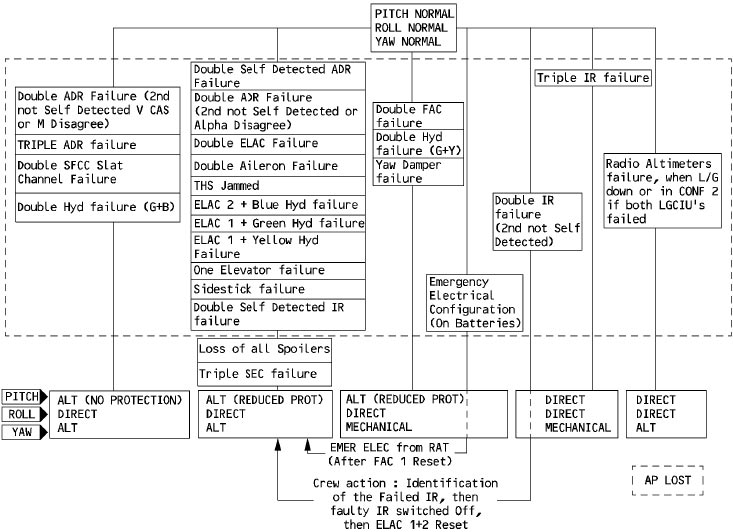
And if you need the diagram for the A330 I’ll gladly post one up for you. For AF447, once the aircraft enters alternate law, some minutes before the stall, this so-called “PCOS” doesn’t work (look up Airbus Alternate 2 Flight Control Law).
I noted that in your claims you have not stalled any Airbus FBW aircraft (outside Normal Law) and Boeing FBW aircraft…
Your writing suggests that it is you who are limited in your knowledge of FBW systems (in particular Airbus’).
Now… Max Thrust if tied to AutoThrottles? Again, it shows your lack of knowledge in Airbus FBW systems. It’s AutoThrust by the way (different terminology deliberately made to disconnect the mindset from coupled auto-throttle with throttle levers). Autothrust does not go to max thrust in a stall under ALTN2 on A330 or under A320 ALT (Reduced Prot) because the stall protection by thrust is not operative.
Please, show some evidence that you have read the manual of an Airbus FBW FCOM before you throw your rubbish here. Commercially, I don’t mind you posting this junk as it generates revenue for me, but objectively… there is no point if you don’t want to discuss this based on FACTS (ie: try reading the manual as a starting point… if you don’t have one… then save your dignity).
So, have you?